Article
Crieff, Perthshire I: The ‘Holiday Town' and Gateway to the Highlands of Scotland
Author(s):
Crieff is farmers' fields and unhurried rivers. Manor houses and simple homes. Schoolchildren in uniforms. Butchers with striped aprons. Cobblestones. Shop windows showing whisky bottles and all the varieties of the kilt. Hills. Pedestrians everywhere. Cars searching in vain for street parking.
Born in Crieff, Scotland a long, long time ago I was not overly impressed by a market town of 6,000 people but what child notices things like the minimalism of serenity? Yet the stuff that enabled a young person to have a perfect childhood then (except for an ear tweaked by a policeman when caught stealing apples from a neighbor’s orchard) are the same things that might delight a visitor coming from the frenzy of today’s modern life.
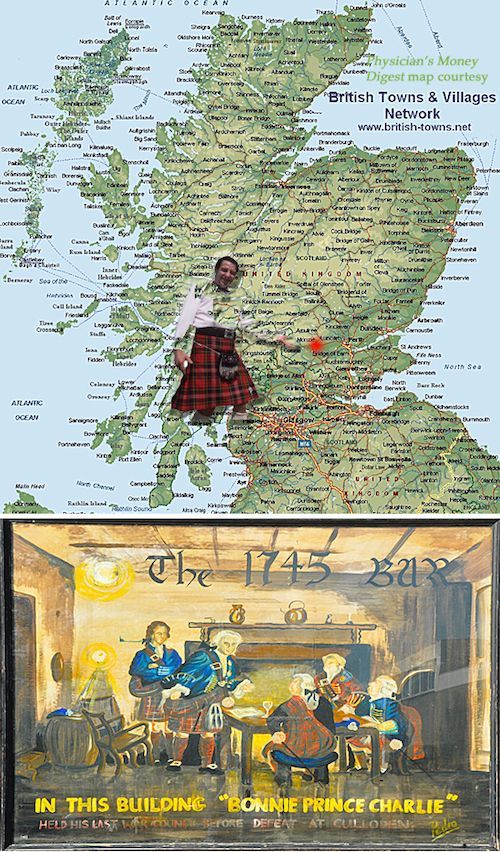
We’ve taken a cheerful Scot out of one of our photographs, added a red dot for the location of Crieff and had him demonstrate where the town lies. Crieff’s history includes a council of war held in 1745 in a local hotel, now derelict, by Bonnie Prince Charlie, the Young Pretender to the Scottish throne. He lost the Battle of Culloden and his claim the following year.
The battles are over. Now Crieff is serenity. Crieff is farmers’ fields and unhurried rivers. Manor houses and simple homes. Schoolchildren in uniforms. Butchers with striped aprons. Cobblestones. Shop windows showing whisky bottles and all the varieties of the kilt. Hills. Pedestrians everywhere. Cars searching in vain for street parking.
There are caveats. It is very busy in summer especially during the school holidays but that is true all over Europe. Traffic is terrible. The town clings to the side of a 900 foot-high hill called the Knock and that’s what your knees will be doing if you burn out your clutch trying to hold your rental car poised on the brink of a town cross-street while you wait for traffic to pass. Not a problem if you rent an automatic as most Americans do in Europe. The parking issue, to a degree, is resolved by a central car park a hundred yards’ walk from downtown.
But walking delightful places is a genuine pleasure in Crieff and depending where you stay you may not need your car. Let’s talk about that first.
Accommodations
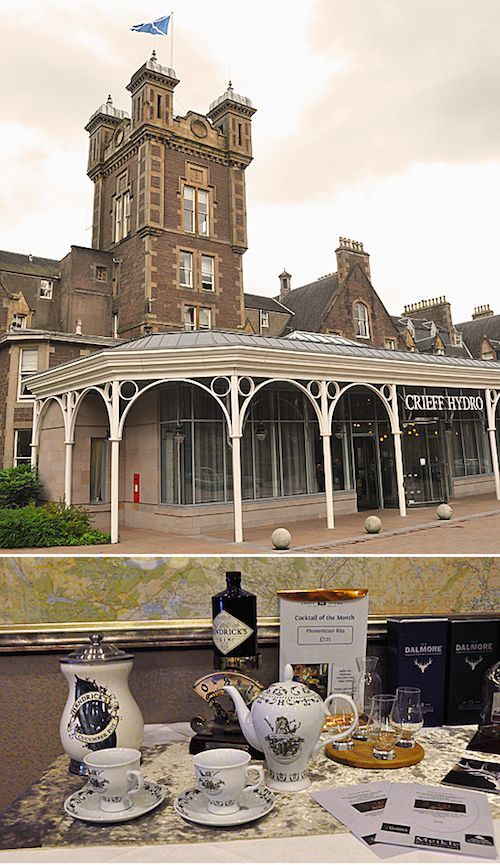
So-called hydropathic hotels dot Scotland’s landscape, relics of the Victorian preoccupation with the supposed and probably imaginary health benefits of spas. The one in Crieff is simply called the Hydro. It’s upscale and exactly what most well-off Americans would like and even expect in Britain. It has its swimming pool, golf course, and riding stables. And many activities for busy families.
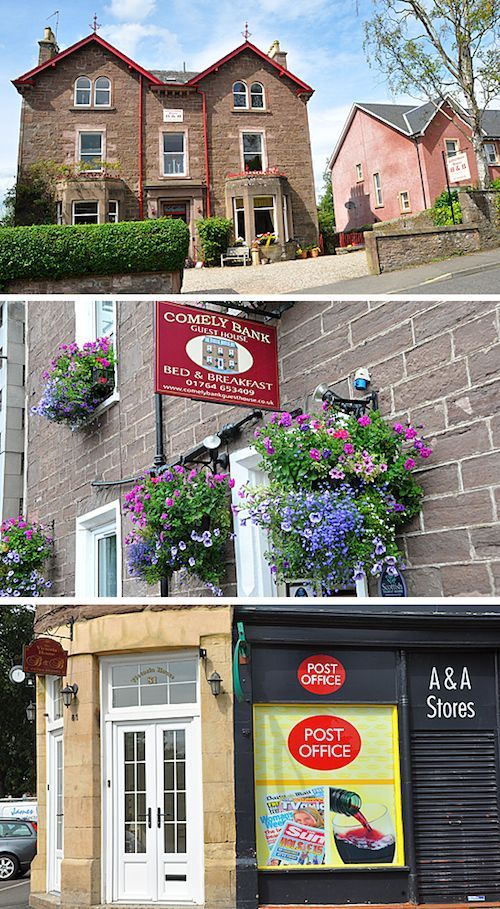
Several B & Bs are available in town. Websites give the relevant information. Galvelmore House (top image) was the home and office of one of the town’s beloved family physician, Dr. Haig. Comely Bank (with its wall of flowers) lower image has several rooms and is close to the supermarket. Victoria House sits at the bottom of the town with a 200 yards walk up a hill to downtown but it’s close to a supermarket, too, and a convenience for most guests.
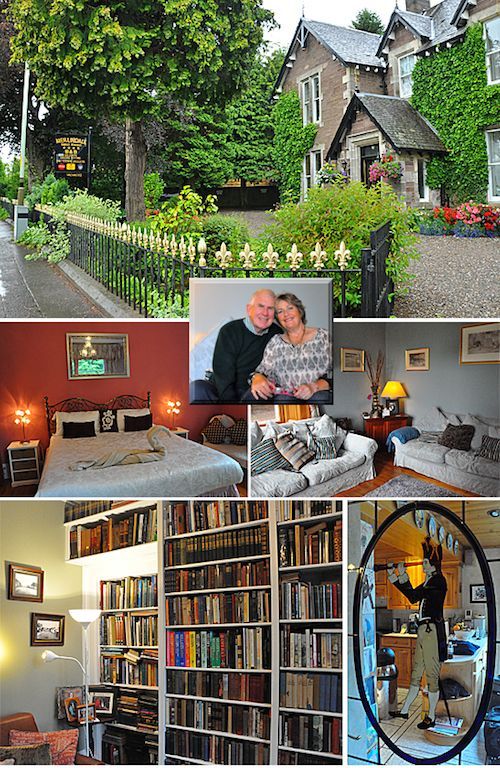
Visitors accustomed to upscale travel might enjoy the Michelin Guide (and Scottish Tourist Board) award-winning Merlindale. We checked it out in person, for several reasons—something we had not done with the other accommodations. Merlindale because it was right bedside Yann’s, an attractive restaurant we felt would please American tourists, because the owners were pleasant and fun people, and because they were recommended by my sister in law who lived near them and knew them as genuinely nice people. John was a typical carefree Scot; his wife Jacky was born in Johannesburg, South Africa and speaks 6 languages. More important to guests is, says her husband, she has a Cordon Bleu diploma from the London School of Cordon Bleu—but “doesn’t like haggis.”
Where to Eat
My parents and brother and my sister-in-law ran essentially the only restaurant in Crieff in 1944 as the war was ending in Europe, There was little competition but not much food available but I see from today’s search engines there are now more than 30 places to eat in town.
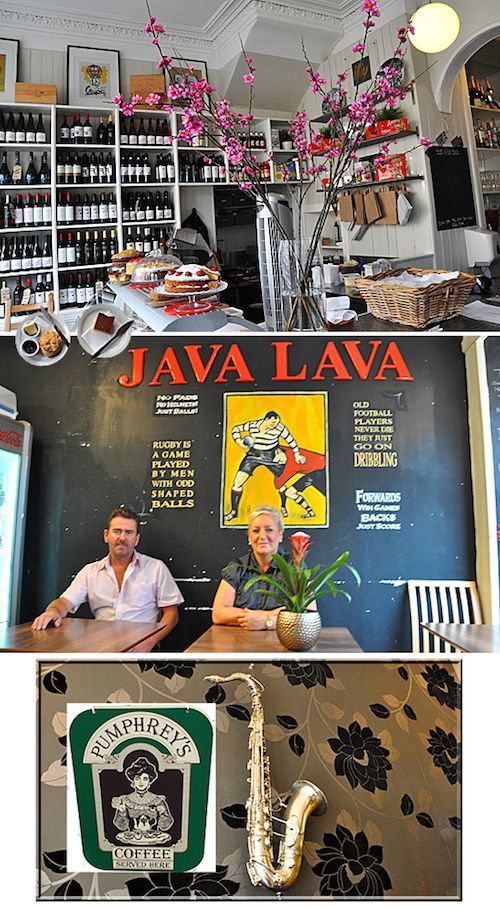
Top image: Delvino’s. The 2 plates flowing into the middle image of Java Lava are from a coffee break with a Scottish scone at Delvino’s. Lower image: The Lounge (it does great hamburgers).
You can dine at the Hydro but locals feel Yann’s is a delightful, special place for fine dining. We enjoyed a meal there that seemed a bit pricey but found other places less formal and less expensive. Delvino’s at the start of King Street and on High Street, Java Lava, and The Lounge all offered excellent simple lunches. Scottish people often advise having lunch in the local pub as their food is less costly and often adequate. We have to say we find Europe more expensive that the United States whether you are buying clothes or ordering a meal. So enjoy the free outdoors.
What to See in the Great Outdoors
Tourists in Crieff don’t really need a car not once they get there. What they may need are sensible walking shoes. Stout sneakers may be enough. We’ve seen flip flops on some tourists who seemed to be OK but we don’t advise it.
There are 2 special unique walks in this countryside, all starting about a mile from the High Street downtown.
Up the Knock
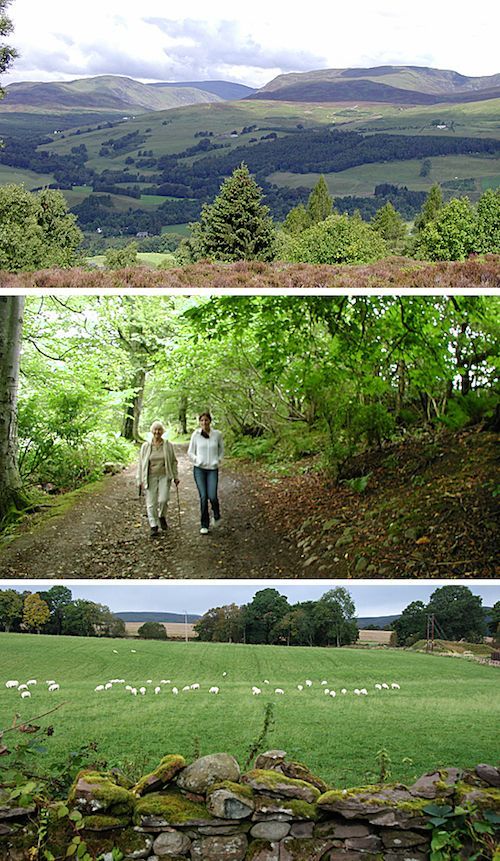
Top image: View of Glen Turret and the Blue Crags from the top of the Knock. Middle image: Most of the paths that circle the Knock are pleasant strolls. Bottom image: One of the paths leading into another walk, Lady Mary’s Walk.
I say “Up” because that’s where you’ll be going. The streets in town that lead to where you might start the walk are themselves steep. Family physicians in Crieff say they never need to send their elderly patients for cardiac evaluation; if they’ve survived walking in Crieff for most of their life they have already had a successful stress test. The walk is broken into 5 stages at this website which specifies the round trip is about 3.75 miles. The walk itself is gradual and I feel easy for those not in a hurry—and why be rushed on vacation?
Lady Mary’s Walk
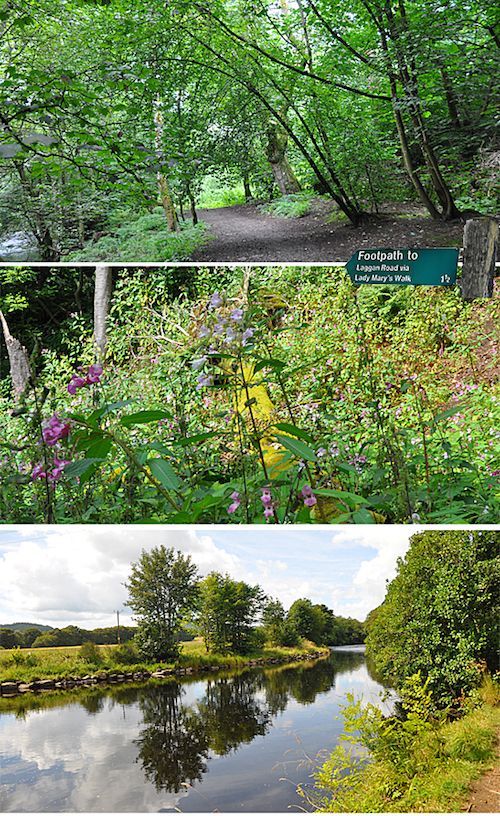
Lady Mary’s Walk.
This is a gorgeous lazy walk. Babbling brooks, a serene river, wild flowers, oak and beech trees laid out as if in avenues. Mostly easy, flat-footing with choices of 3.5 miles to 4.5 miles according to the walkers’ wishes. One of the most peaceful walks in Perthshire. The walk can end or start in MacRosty Park, the groomed almost manicured garden on the west side of town.
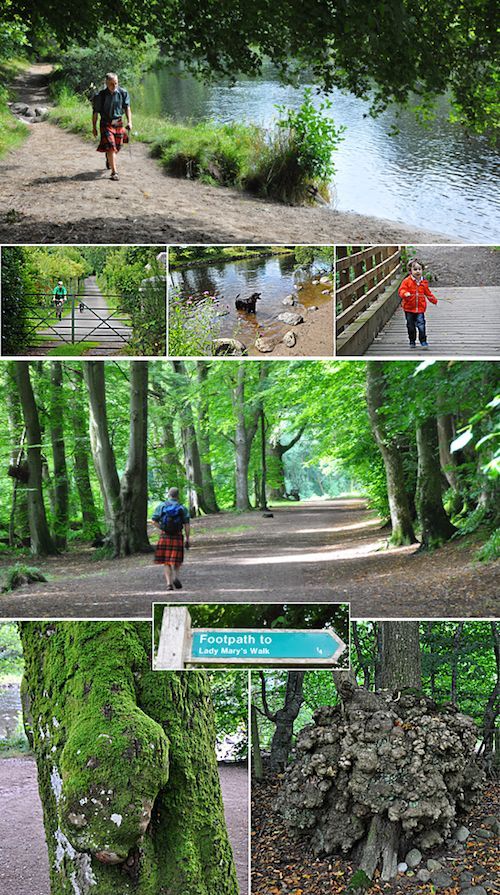
Lady Mary’s Walk. Magnificent avenue of trees. At this point you can take a right and cut a mile off the walk, or head straight.
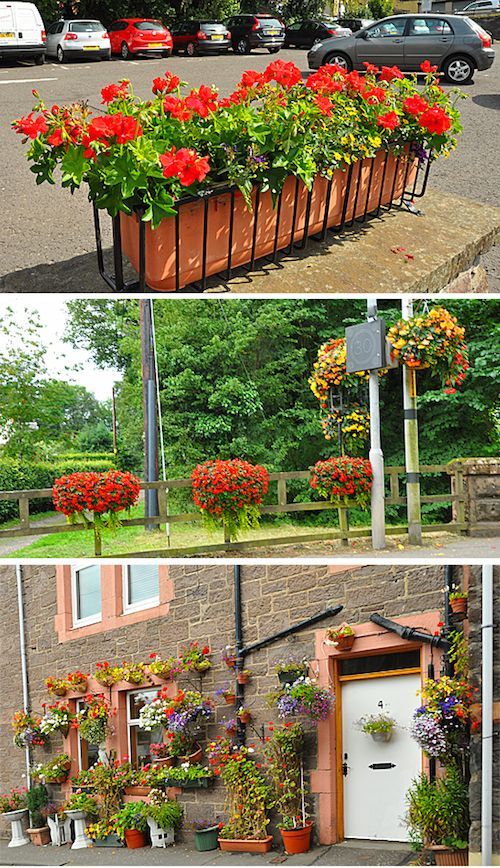
The Crieff area is ablaze with flowers. Top image: The entrance to the town car park! Middle image: Entrance to Comrie village. Bottom image: A wall on a house in Crieff maintained by a widower as a tribute to his wife.
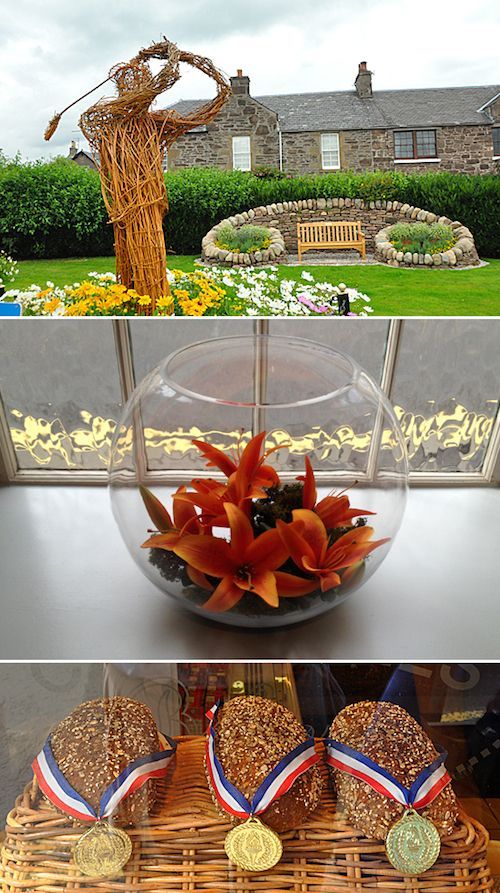
Crieff reminds people driving past it has an 18-hole golf course. Flowers in the Crieff Hotel. Medals in Campbell’s Bakery showing it has won many awards for its bakery.

The Tower Hotel is now under new ownership; it has interesting architecture, a restaurant with a great new to the south and a wait staff with rough edges but it’s worth a visit. James Square in the center of the town sometimes has pipe band performances.

The town clock tower holds the tourist office, the Crieff Information Centre, with all its pamphlets, maps, and useful suggestions. This is the official site. The Crieff Visitor Centre is a more commercial arrangement with a couple of quality shops and a restaurant where I usually eat my once-a-year haggis. Try haggis; just don’t ask too many questions. The Centre is at the bottom end of Crieff whereas the (first-mentioned) Information Centre is at the top end beside James Square. Downstairs from the Information Centre you’ll find a modest free museum, “Stocks, Stones & Stories,” a home now for the 9th Century Burgh Cross that used to stand outside in all weathers. Brought inside also to reduce its deterioration in the damp of Scottish summers are the Crieff Stocks.
I recall a long time ago peering through the iron fence below the town clock at those iron bars meant to immobilize the town’s delinquents—and hearing my mother promise I would get to know those bars really well if I ever were naughty. The stocks were in great use from at least the 800s; the Crieff ones were last used in 1816 and were found in a cell when the Old Tollhouse was pulled down in 1840. Towns were ordered by an Act of Parliament on 1574 to provide stocks for the punishment of wrongdoers and since the Scots are said to be frugal, er, cheap, the stocks in Crieff could accommodate 4 persons at one time!
And since Crieff is “the Gateway to the Highlands” we’ll tell you next week—if you have a car—what’s a mere 1 or 2 hours’ drive away from town.
Photography by the author
The Andersons, who live in San Diego, are the resident travel & cruise columnists for Physician's Money Digest. Nancy is a former nursing educator, Eric a retired MD. The one-time president of the New Hampshire Academy of Family Physicians. Eric is the only physician in the Society of American Travel Writers. He has also written 5 books, the last called The Man Who Cried Orange: Stories from a Doctor's Life.




